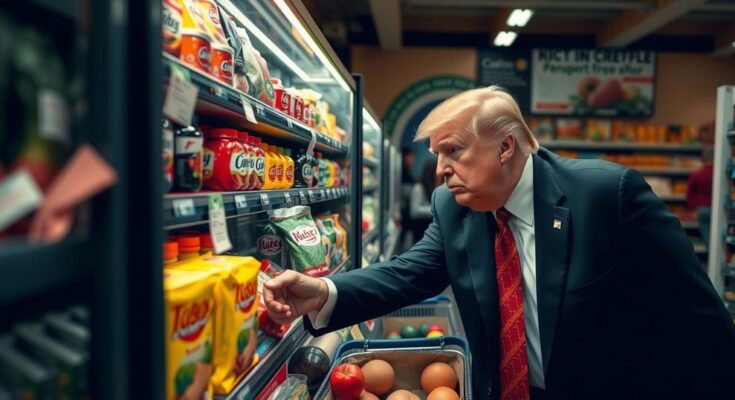Amid rising food costs, many American voters are looking to President-elect Trump for relief, yet experts warn his proposed tariffs and policies could worsen prices. Food inflation, rooted in complex factors, continues to burden consumers, creating a disconnect between political promises and economic realities. Long-term solutions may be necessary to address grocery prices effectively.
As grocery bills remain a pressing concern for American voters, many have turned to President-elect Donald Trump, hopeful he can ease their financial strain. With food prices soaring due to complex factors like the pandemic and global conflicts, Trump has made bold promises to lower costs, asserting he can address inflation caused by rising prices in staples like bacon and cereal. Yet, economic experts caution that his strategies, including increased tariffs on imported food and the deportation of undocumented workers, might lead to higher prices instead of relief. According to federal data, food prices for home consumption surged by 28 percent since 2019, reflecting a dramatic inflationary spike through 2022. While recent statistics indicate a modest rise of just 2 percent in the past year, voter concerns remain pronounced, with about 70 percent expressing significant anxiety about food costs. Trump’s proposal for tariffs aimed at boosting domestic farmers could backfire—forcing food producers to pass on the increased costs of essential imports like fertilizer and equipment to consumers. While Biden’s 2021-era statistics indicated that U.S. farms rely on imported ingredients, Trump’s aggressive tariffs risk not only escalating some of these costs but also stifling agricultural exports, as other countries might retaliate. The Trump administration’s plans to address energy costs, which are only a small part of overall food production expenses, also seem insufficient to provide immediate relief. Economists argue that sustainable reductions in grocery prices may require broader changes in agricultural policy rather than quick fixes. With diverse opinions among voters, one assertion holds true: a president’s power to address grocery prices significantly, especially in the short term, is limited. Experts believe long-term solutions could involve fostering competition and investing in resilient agricultural practices. Meanwhile, the public’s desire for immediate price declines—reflecting pre-pandemic levels—remains unrealized, leaving many to question whether political promises can genuinely alleviate their economic burdens.
The article delves into the current state of food prices in the United States and highlights the concerns of voters regarding rising grocery costs. With Donald Trump newly elected, many citizens look to him for solutions, citing his campaign promises. However, the complex causes of food price inflation raise doubts about the effectiveness of his proposed policies, such as tariffs, which could exacerbate the situation. The dialogue emphasizes the disconnect between voter perceptions and economic realities.
In summary, while many voters are pinning their hopes on Trump to resolve surging grocery prices, economic experts warn that his proposed solutions could lead to increased costs instead. As food inflation persists, the interplay of tariffs, energy prices, and reliance on imports complicates the picture. True relief may require long-term policy adjustments rather than immediate promises, highlighting the challenges in balancing public expectations with economic realities.
Original Source: www.pbs.org



